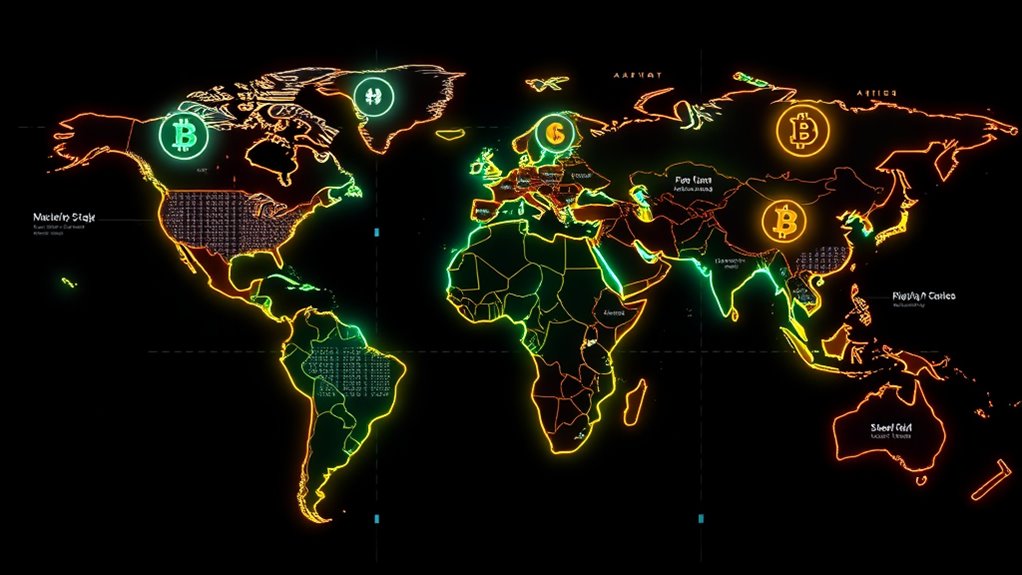Around the world, countries treat altcoins very differently based on their economic goals and regulatory climate. Some, like the US and Canada, focus on balancing innovation with investor protection, while the EU pushes for strict standards through MiCA. Asia-Pacific countries vary from China’s ban to Japan’s acceptance, and regions like Africa and Latin America are exploring cryptos for financial inclusion amid uncertainties. If you continue exploring, you’ll uncover how these varied approaches shape the future of crypto markets globally.
Key Takeaways
- Countries like the US and EU regulate altcoins through licensing and transparency standards, aiming to protect investors and prevent money laundering.
- Japan recognizes cryptocurrencies as property, applying specific regulations that also cover altcoins, encouraging innovation and consumer protection.
- China enforces strict bans on all crypto activities, including altcoins, to prevent financial risks and maintain control over the market.
- Some regions, such as Russia and Eastern Europe, impose restrictions or bans on altcoin trading, while promoting blockchain development to foster innovation.
- Countries like El Salvador and Brazil adopt a more open approach, with growing trading volumes and less strict regulation on altcoins to support financial inclusion.
North America: Regulatory Approaches in the United States and Canada

North America exhibits diverse regulatory approaches to cryptocurrencies, with the United States and Canada each adopting distinct frameworks. In the U.S., regulations vary by state, and federal agencies like the SEC and CFTC oversee different aspects of crypto activities. You’ll find some states offering clearer guidelines, while others impose stricter rules or bans. The focus is on protecting investors and preventing money laundering, but regulation remains complex and evolving. In Canada, regulators take a more unified approach. You’re required to register with the Financial Transactions and Reports Analysis Centre of Canada (FINTRAC) if you deal with crypto exchanges or wallets. Overall, both countries aim for balanced oversight, but their methods reflect differing priorities—America’s decentralized approach contrasts with Canada’s more centralized framework.
Europe: The European Union’s Framework for Digital Assets

The European Union has taken a coordinated approach to regulate digital assets, aiming to create a unified framework across member states. This effort seeks to ensure consumer protection, prevent money laundering, and promote innovation. The proposed Markets in Crypto-Assets (MiCA) regulation sets clear rules for issuers and service providers, establishing licensing and transparency standards. It also covers stablecoins and token classifications, providing legal certainty across borders. This harmonization simplifies compliance for businesses and enhances market stability. For example, the regulation addresses vetted products to ensure safety and efficacy in the market, reflecting the EU’s commitment to regulatory clarity in digital asset markets. Monitoring the shelf life of digital assets and understanding their security features can help protect investors and maintain market integrity. Additionally, the regulation emphasizes the importance of transparency in disclosures to foster trust among consumers and stakeholders. Incorporating insights from AI in Education and other technological advancements, the EU aims to stay ahead of emerging risks and opportunities in the digital asset space.
Asia-Pacific: Divergent Policies in China, Japan, and Singapore

Across Asia-Pacific, countries adopt markedly different approaches to cryptocurrency regulation, reflecting varying priorities and economic strategies. China has taken a strict stance, banning crypto exchanges and initial coin offerings (ICOs), and cracking down on mining activities. The government aims to prevent financial risks and maintain control over the economy. Conversely, Japan recognizes cryptocurrencies as legal property, establishing clear regulations that promote innovation while ensuring consumer protection. You can trade and hold altcoins legally under these rules. Singapore positions itself as a crypto-friendly hub, with a regulated environment encouraging innovation and attracting startups. Its licensing regime ensures transparency, making it easier for businesses to operate. These contrasting policies highlight how regional priorities influence crypto regulation, shaping the landscape for investors and developers across Asia-Pacific. Additionally, some countries are exploring regulatory frameworks to foster responsible innovation while protecting consumers and financial stability.
Middle East and Africa: Embracing Innovation or Imposing Bans?

In the Middle East and Africa, countries take very different stances on crypto, balancing innovation with regulation. Some nations embrace digital assets to boost economic growth, while others impose strict bans to protect their financial systems. As you explore this landscape, you’ll see how regulatory approaches shape adoption and create ongoing challenges. The regulatory environment in these regions continues to evolve as governments seek to find a balance between fostering innovation and ensuring financial stability.
Regulatory Approaches Vary
While some Middle Eastern and African countries welcome cryptocurrency innovation, others impose strict bans that hinder its growth. You’ll notice a wide range of approaches across the region.
- Countries like the UAE and Kenya foster innovation with clear regulations and licensing, encouraging startups and investments.
- Conversely, nations such as Algeria and Nigeria enforce outright bans or heavily restrict crypto activities, citing concerns over security and fraud.
- Some governments adopt a cautious stance, monitoring market developments before implementing regulations, balancing innovation with risk management.
- Recognizing the importance of relationships and open dialogue can help foster better understanding and collaboration on regulatory frameworks.
This diversity means your experience with crypto varies markedly depending on where you are. While some regions see blockchain as a growth opportunity, others treat it as a threat, shaping how you can participate in the digital economy.
Adoption Challenges Persist
Despite the varied regulatory landscape, many countries in the Middle East and Africa still face significant hurdles in adopting cryptocurrencies. These obstacles include limited infrastructure, regulatory uncertainty, and lack of public awareness. Some nations lean toward bans, fearing financial crimes or capital flight, while others see potential for innovation. The challenge lies in balancing safety with progress. Additionally, understanding the regulatory environment and its influence on crypto adoption is crucial for stakeholders navigating these markets.
Innovation vs. Restrictions
Countries in the Middle East and Africa are at a crossroads, weighing the benefits of fostering innovation against the risks of imposing restrictions. Some nations see crypto as a tool for economic growth, while others worry about fraud and money laundering. Your role is to understand how different strategies impact the market. Consider:
- Countries like the UAE actively promote blockchain startups, encouraging innovation and attracting investments.
- Conversely, nations like Algeria ban cryptocurrency trading to prevent financial instability.
- Some governments adopt a cautious approach, creating regulations that balance innovation with security measures.
This tension influences whether the region becomes a hub for crypto advancement or remains cautious with strict bans. Your insights can reveal how these choices shape the future of digital assets in the Middle East and Africa.
Latin America: Growing Adoption Amid Regulatory Uncertainty

Latin America is experiencing a surge in cryptocurrency adoption, even as regulatory frameworks remain uncertain and evolving. Many countries in the region see crypto as a way to bypass traditional banking limitations, attract investment, and promote financial inclusion. Countries like El Salvador have embraced Bitcoin, making it legal tender, while others, such as Brazil and Argentina, have seen increasing trading volumes despite unclear regulations. Governments are hesitant to impose strict rules, partly due to the potential for economic growth and innovation. However, this regulatory ambiguity creates risks for investors and businesses. Still, the region’s enthusiasm for cryptocurrencies continues to grow, driven by young populations enthusiastic to explore digital assets. Your involvement in crypto here requires careful navigation of the uncertain legal landscape, but opportunities abound. Additionally, understanding the IRA Investment strategy in different contexts can inform smarter decision-making within this dynamic environment. Recognizing the importance of regulatory clarity can help investors better assess risk and opportunity in these markets. Moreover, regional differences in cryptocurrency regulation can significantly impact market stability and investor confidence. As the sector expands, staying informed about legal developments becomes essential for all participants. Furthermore, the emergence of new market controls could shape future adoption trends and regulatory responses in the region.

Russia and Eastern Europe present a complex landscape of crypto regulation, where government control plays a major role. You’ll find some countries experimenting with state-led crypto projects, while others impose strict bans and restrictions. Understanding these varying approaches is key to grasping how crypto fits into the region’s political and economic frameworks. Additionally, the evolving regulatory environment raises concerns about AI vulnerabilities that could impact digital asset security and governance. These concerns are compounded by the need for robust regulatory frameworks to ensure safe adoption and prevent misuse, especially as countries explore different models of cryptocurrency regulation. Furthermore, the divergent regulatory strategies can influence the level of market stability and investor confidence across the region. The implementation of tuning techniques from automotive enhancements can serve as a metaphor for adjusting regulatory settings to balance innovation and control.
Regulatory Environment Overview
While Eastern Europe presents a diverse landscape for cryptocurrency regulation, Russia stands out for its cautious yet assertive approach to state control. The government emphasizes monitoring and restricting crypto activities to maintain financial stability and security. Here’s what you need to know:
- Russia bans the use of cryptocurrencies for payments but permits their possession and trading as property.
- The Central Bank remains skeptical, proposing tighter regulations and potential bans on certain crypto operations.
- Despite restrictions, cryptocurrency use persists, with many residents engaging in trading through peer-to-peer platforms.
This environment reflects a balance between cautious oversight and the recognition of crypto’s growing role in the economy. As a user, you must stay informed of evolving laws to navigate this complex regulatory landscape effectively.
State-Controlled Crypto Initiatives
In Eastern Europe, governments are actively shaping their approaches to cryptocurrency by implementing state-controlled initiatives that balance regulation with strategic oversight. Russia, for instance, has created a framework allowing its citizens to buy and sell cryptocurrencies under strict rules, while closely monitoring transactions to prevent illegal activities. The government views crypto as a tool for economic growth but maintains control to safeguard financial stability. Other Eastern European countries, like Belarus, have launched state-backed blockchain projects to promote innovation and integrate digital assets into their economies. These initiatives aim to foster technological development while ensuring that the state retains oversight over crypto activities. By establishing clear policies, these nations seek to harness the benefits of cryptocurrencies without losing control over their financial systems. Additionally, understanding the legal aspects of separation is crucial for individuals navigating the evolving landscape of cryptocurrency regulation and ownership rights. Furthermore, some countries are implementing comprehensive regulatory frameworks to provide clarity and stability in the digital asset markets, which can include transparent licensing procedures to ensure compliance.
Cryptocurrency Bans and Restrictions
Have you wondered how Eastern European countries are balancing their desire to regulate cryptocurrencies with the need to prevent illegal activities? Russia and neighboring nations often impose strict bans and restrictions to maintain control. Here are three key points:
- Russia has banned the use of cryptocurrencies for payments but allows their ownership and trading, creating a confusing legal landscape.
- Many Eastern European countries limit crypto exchanges, requiring heavy regulation and licensing to curb money laundering.
- Governments frequently block access to crypto platforms or shut down local exchanges to prevent unauthorized transactions.
- The evolving regulatory environment in these countries reflects ongoing efforts to balance innovation with security concerns. These measures are also influenced by privacy and cookie policies that impact how online platforms operate within these restrictions.
These measures aim to regulate crypto activity while minimizing illegal use, but they also challenge the balance between innovation and control. You need to stay informed about evolving policies to navigate this complex landscape effectively.
Developing Countries: Opportunities and Challenges for Altcoin Markets

Developing countries are increasingly recognizing the potential of altcoins to boost financial inclusion and economic growth. They see altcoins as tools to reach unbanked populations and facilitate remittances. However, challenges like limited infrastructure, regulatory uncertainty, and volatility pose hurdles. Governments must balance encouraging innovation with protecting consumers. Some nations offer supportive environments, while others impose restrictions that hinder growth. Opportunities include creating local digital currencies and attracting foreign investment. Challenges involve potential misuse for money laundering and scams. To succeed, developing countries need clear policies and infrastructure upgrades. Additionally, understanding ice cream terminology and ingredients can serve as a metaphor for the importance of clear definitions and standards in the regulation of digital assets. Recognizing the importance of regulatory clarity can help countries establish effective frameworks for the responsible development of altcoin markets. Building robust regulatory frameworks is essential for fostering investor confidence and sustainable growth in these markets.
Global Trends: Harmonization and International Cooperation Efforts

As countries recognize the growing importance of cryptocurrencies, efforts to harmonize regulations and foster international cooperation have gained momentum. You’ll notice organizations like the G20 and FATF working to create unified standards, making cross-border transactions smoother and reducing risks. These initiatives aim to:
- Establish consistent anti-money laundering (AML) and know-your-customer (KYC) protocols across nations.
- Develop global frameworks for taxing and reporting crypto assets.
- Promote information sharing among regulators to prevent illicit activities and protect investors.
This collaboration helps prevent regulatory arbitrage, where companies exploit differing rules. By working together, countries can create a safer, more stable environment for crypto markets, encouraging innovation while safeguarding financial systems worldwide.
Frequently Asked Questions
How Do Different Countries Classify Various Types of Altcoins Legally?
You might wonder how countries classify altcoins legally. Generally, jurisdictions differ: some see them as securities, requiring compliance with financial regulations, while others treat them as commodities or property, affecting taxation. Certain nations ban specific altcoins altogether, citing concerns over fraud or stability. You should check your local laws to understand how your country categorizes different altcoins, ensuring you stay compliant when trading or investing.
What Are the Penalties for Non-Compliance With Crypto Regulations Internationally?
You wonder about the penalties for non-compliance with crypto regulations worldwide. The truth is, they can be severe—ranging from hefty fines and confiscation of assets to criminal charges and imprisonment. Countries are increasingly cracking down on violations to protect investors and maintain financial stability. So, if you ignore these rules, you risk facing serious legal consequences, which could jeopardize your entire crypto journey. Stay informed and compliant to avoid these dangers.
How Do Tax Policies Vary for Altcoin Trading Across Countries?
You’ll find tax policies for altcoin trading differ widely depending on where you are. Some countries treat gains as taxable income, requiring you to report profits annually, while others offer more lenient or even no capital gains taxes. You need to stay informed about local laws to avoid penalties. Always keep detailed records of your trades, and consider consulting a tax professional familiar with your country’s regulations to stay compliant.
Are There International Standards for Anti-Money Laundering in Crypto Markets?
You might be surprised to learn that only about 50 countries have adopted specific anti-money laundering (AML) regulations for crypto markets, with many still developing standards. Currently, there are no universal AML rules, so you need to stay informed about different countries’ policies. While international organizations like FATF provide guidelines, enforcement varies, meaning your compliance efforts should be tailored to each jurisdiction’s requirements to avoid legal issues.
How Do Cross-Border Transactions Impact Regulatory Enforcement for Altcoins?
Cross-border transactions make regulatory enforcement more complex because they involve multiple jurisdictions with varying rules. You might find it harder to track and verify altcoin transfers across borders, increasing the risk of illegal activities. Governments and regulators need to collaborate more closely, share information, and develop unified standards. This way, you’ll have a better chance of ensuring compliance and preventing misuse of altcoins in international transactions.
Conclusion
As you explore global crypto regulations, remember that over 80% of countries are actively updating their policies, shaping the future of altcoins worldwide. Whether embracing innovation or imposing bans, each nation’s approach impacts your ability to trade, invest, and innovate. Staying informed helps you navigate this evolving landscape and seize opportunities. As the world moves toward greater cooperation, your involvement can help shape a more inclusive and secure crypto future.










